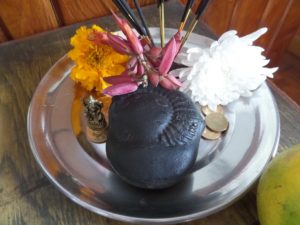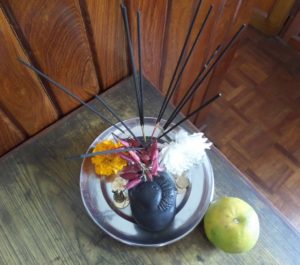Today marks, roughly, the half-way point of my long-term fieldwork. I have been in Nepal now some five months (with three months previous to this a year ago, and another three months previously in India) and will remain in Kathmandu until the spring, when I leave once again for the Kali Gandaki River valley of Mustang. This is the point of ethnographic fieldwork where one is generally advised to take stock, review everything collected so far, and consider what gaps might remain outstanding that can be addressed in the coming months. It seemed like such a simple task at first.
My fieldnotes are already, and some might say miraculously, somewhat organized. My primary notebook, which is sadly starting to show its mileage at this point (thanks Duct Tape!), is replete with colorful tape flags and Post-Its marking areas of specific interest or categorizing certain discussions for certain chapters. I also have a sense of an overall framework already in the works and have been plugging in information to relevant sections as I go along. This drafting stage for the final book isn’t specifically to just “get it all done,” so to speak, but to help me see what might be missing or what might not be as clear as it first appeared. This way, when I conduct more interviews or sit-in on a few more pujas and festival celebrations, I’ll know what it is I need to ask. But this still leaves me with something of a conundrum. A large portion of my fieldnotes are in drawings.
As I discussed earlier, many of these drawings (which are mainly drawings of specific Shaligrams) will be incorporated into the final piece of the larger work as a kind of “field guide.” But this still leaves out many other drawings that don’t quite fit the needs of such a chapter nor does it address the countless jottings and annotations covering almost every inch of two additional notebooks, two sketchbooks, some pilgrimage pamphlets, and a quick-access field book. I am certainly not the first ethnographer to encounter these problems. As such, there are even books and classes on just this problem; each with their own perspectives. How to fight with fieldnotes, and win.
There is never more poignant a day when you have to sit down with everything you’ve collected and try make some sense out of it. In my case, the metaphor of the museum collection is rather apt. I have a pile of objects in front of me (both notebooks and literal fossil stones) and now I need to arrange them in such a way as to tell the right kind of story. To construct some kind of coherent narrative out of the bits and pieces of encounters and conversations and observations made over more than a year of research. It’s at this point that the academic truly begins to struggle: how do I craft a narrative out of this that will both do it justice and be readable? How am I supposed to decide what is what, when half the time my research participants couldn’t even decide that!? Am I doomed to failure no matter what I do?
In the end, I have decided that the best route is to combine drawing and writing, photography and textual references, so that this research can focus more on the process of drawing out analytical connections from my informants’ multiple threads of narrative and experience. This is because Shaligrams truly do evolve over time (double-meaning intended). As I start now to sit down and write out these narratives, I will continue to try to preserve the numerous voices and perspectives of Shaligram practitioners themselves as the core of my ethnographic and theoretical discussions. As one Shaiva sÄdhu explained, sitting outside the gates of Muktinath as he had off-and-on for some twenty years or so: “The beauty of Shaligram is that it can be many things to many people. This doesn’t mean that you should not learn to read them properly, but that whatever Shaligram is to you may not be what Shaligram is to me. And that is ok, because Shaligram always is what it must be.â€
While at the time I took him to mean that the nuances of Shaligram interpretation may sometimes be left to individual perceptions or insight, I later began to understand that what he was really referring to was a far-reaching sense of the formlessness of the divine: where the superficial nature of the material object and of the narrative was meant only to lead one to deeper understanding, not to be that understanding in and of itself. He contentedly assured me a few moments later that because of this, whatever it was that I would write couldn’t be completely correct no matter what I did, but that it would be enough, for the right person who could read it properly.
Having already experienced some of the challenges of the academic peer review process, I take a strange comfort in that.


